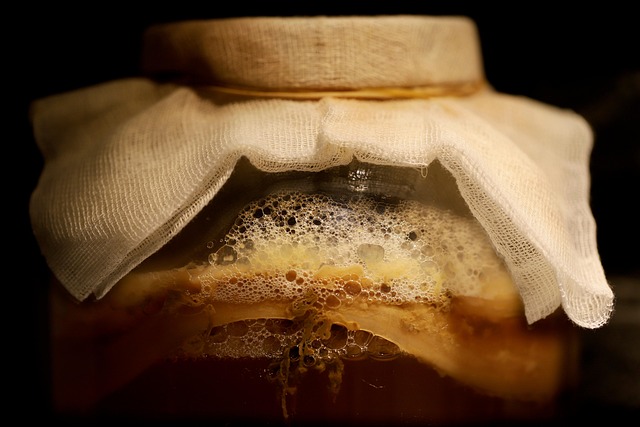What Fermentation Actually Is
At its core, fermentation is a chemical process. Microorganisms—mostly bacteria and yeast—consume sugars and starches to produce something new, like lactic acid, alcohol, or gases. For thousands of years, humans have used this process to make food last longer, taste better, and, more recently, support internal health.
The technique dates back more than 9,000 years. Early cultures, across every continent, figured out how to ferment everything from cabbage to milk to grains. It started as a preservation method—no fridges, no freezers, just natural fermentation keeping food safe and edible well past harvest.
Fast forward to today, and fermentation has landed back in the spotlight. This time, not just for shelf life, but as a driver of flavor and gut health. Live cultures—what we now call probiotics—help rebalance the microbiome, support digestion, and even play a role in immunity. At the same time, fermented foods offer punchier taste profiles and longer-lasting storage without chemical preservatives.
So whether you’re into the tang of kimchi or the fizz of kombucha, fermentation matters. It’s tech that never stopped working—it just finally caught our attention again.
The Real Health Benefits
Fermented foods aren’t just an old-school method of preservation—they’re metabolic gold. At the heart of it all are probiotics, the good bacteria that flourish during fermentation. When you eat fermented foods, you’re essentially feeding your gut new allies. These microbes help break down food more efficiently, soothe inflammation, and can reinforce the gut lining—all of which strengthens immunity in a big-picture way.
But the benefits don’t stop at digestion. Fermentation boosts certain vitamins, especially B vitamins and vitamin K, and can increase the body’s ability to absorb minerals like iron and zinc. In short: the nutrients are not just present—they’re more available to your system.
There’s also promising research around how fermentation can reduce or alter compounds that trigger intolerances. For example, fermented dairy tends to be lower in lactose, making it easier to digest for many people with lactose sensitivity. Some forms of fermentation even reduce gluten content slightly, although that’s not a free pass for anyone with celiac.
Clinical science is backing this up. A growing body of studies points to regular intake of fermented foods improving microbiome diversity, reducing markers of inflammation, and in some cases, improving mental well-being. The data’s still evolving, but the trend is clear: fermentation is more than a fad. It’s functional fuel.
Popular Fermented Foods You Should Know
Let’s get into the stuff you’ll actually want to keep in your fridge.
Kombucha A little sweet, a little tangy, and always fizzy—kombucha has become the gateway fermented drink. It’s made by fermenting tea with a SCOBY (symbiotic culture of bacteria and yeast), which pumps in the live cultures your gut craves. Just watch the sugar content—some brands get heavy-handed.
Sauerkraut & Kimchi These fermented cabbage classics are sharp and punchy—and they go way beyond the hot dog stand. Sauerkraut is straightforward: cabbage and salt. Kimchi brings heat, garlic, and often seafood-based umami. Both are packed with probiotics, fiber, and flavor. Bonus: they’re cheap and easy to make at home.
Yogurt & Kefir Dairy’s answer to fermentation. Yogurt is thicker, easier to spoon. Kefir is drinkable, tangier, and usually has more strains of beneficial bacteria. Both support gut health and come in plain or flavored versions—just steer clear of the sugar bombs hiding under “fruit on the bottom.”
Miso, Tempeh & Natto Fermented soy has range: miso is a salty, umami-packed paste used in soups and marinades. Tempeh is firm and nutty, great for slicing and grilling. Natto is the wild card—sticky, funky, and definitely an acquired taste. But it’s a powerhouse of protein and vitamin K2.
How to Pick Quality Fermented Foods Read the labels. Look for “live” or “raw” cultures and avoid products that have been pasteurized after fermentation—that process wipes out the good bacteria. Choose items with minimal ingredients and no weird additives. And when possible, go for glass jars over cans or plastics—better for the bugs, better for you.
DIY Fermentation: How to Start at Home
You don’t need a high-tech lab to ferment foods. In fact, your kitchen likely already holds most of what you need. Grab a few glass jars, a sharp knife, cutting board, mixing bowl, a clean towel, and either rubber bands or metal jar lids. For yogurt, a food thermometer and a warm place to incubate (like an oven with the light on) come in handy. Optional but helpful tools include a fermentation weight, airlock lids, and a digital scale.
Safety First
Fermentation is safe when done properly, but it’s not a free-for-all. Wash your hands, sterilize containers with boiling water or vinegar, and make sure vegetables stay submerged in brine to prevent mold. A little white fuzz is usually yeast (harmless), but pink, black, or foul-smelling growth is a hard no—toss it. Trust your senses.
Step-by-Step: Basic Recipes to Start With
1. Simple Sauerkraut
Ingredients:
- 1 medium cabbage
- 1 to 1.5 tablespoons salt (non-iodized)
Instructions:
- Shred the cabbage, sprinkle with salt.
- Massage the cabbage for 5–10 minutes until it releases liquid.
- Pack it tightly into a jar. Press down so the brine covers the cabbage.
- Cover with a cloth or loosely fitted lid. Let it ferment at room temperature for 5–10 days, tasting along the way.
2. Easy Homemade Yogurt
Ingredients:
- 1 quart milk (whole works best)
- 2 tablespoons plain yogurt (with live cultures)
Instructions:
- Heat the milk to about 180°F, then let it cool to 110°F.
- Stir in the yogurt.
- Pour into jars, cover, and keep warm (110°F) for 8–12 hours.
- Chill before eating. Keep a few spoonfuls to start the next batch.
Tips for Experiments and Scaling Up
Once you’re comfortable, try adding shredded carrots, garlic, or chili flakes to sauerkraut. For yogurt, mix in honey or fruit purée after fermentation. Batch scaling is simple: just maintain salt or starter ratios. With each round, you’ll refine your process—and your flavors.
Fermentation isn’t hard. It just needs attention, patience, and a clean setup.
Fermentation and the Modern Food Movement
Artisanal food methods aren’t just surviving—they’re getting a second wind. In a world leaning heavy on ultra-processed, convenience-first meals, slow fermentation feels almost rebellious. We’re seeing more small-batch producers, home fermenters, and indie brands going back to basics: live cultures, hands-on techniques, minimal ingredients.
But this isn’t nostalgia for its own sake. These old-school methods line up with modern values—sustainability, transparency, and a tighter supply chain. When you ferment cabbage into sauerkraut using just salt and time, you’re cutting waste, avoiding excess packaging, and choosing a low-energy preservation method. No factory required. No artificial anything.
Whether it’s kombucha brewed in five-gallon glass jars or miso aged in cedar barrels for months, people are drawn to the tangible care behind craft production. It’s food with a backstory—and that matters.
Want a broader look at how artisanal methods are redefining modern eats? Check out our full piece on Artisanal Foods & the Rise of Craft Production.
Final Thoughts: Small Batches, Big Impact
When it comes to fermented foods, consistency is king. Dumping a mountain of kimchi into your diet for one week won’t do much if you ghost it the next. The real benefits—better digestion, stronger immunity, improved nutrient absorption—come from regular, moderate intake. Think of it like feeding your gut’s ecosystem. It craves steady nourishment, not chaos.
That said, there’s no one-size-fits-all plan. Some folks thrive sipping kefir in the morning. Others like pickled veggies alongside dinner. Maybe your thing is weekly batches of sourdough or a touch of miso in soups. The key is fitting fermentation into your routine in ways that feel doable, not forced.
The beauty of fermentation is that it bridges old-world wisdom with modern wellness. You don’t need a farm or a fancy setup—just some awareness, a glass jar, and a little patience. Whether you’re going full DIY or just adding store-bought sauerkraut to your plate, the practice is about slow, intentional nourishment. Let your gut get familiar with the good stuff. Small steps, repeated over time, lead to big changes.

 Thalira Tornhanna, the visionary founder of Food Smart Base, established the platform with a passion for transforming the way people engage with food. Guided by her dedication to health, innovation, and culinary education, she created a resource that not only delivers industry news and nutritional advice but also inspires better cooking practices and highlights emerging food trends. Through her leadership, Food Smart Base has become a trusted hub where readers can discover practical knowledge and fresh ideas that empower them to make smarter choices in their daily lives.
Thalira Tornhanna, the visionary founder of Food Smart Base, established the platform with a passion for transforming the way people engage with food. Guided by her dedication to health, innovation, and culinary education, she created a resource that not only delivers industry news and nutritional advice but also inspires better cooking practices and highlights emerging food trends. Through her leadership, Food Smart Base has become a trusted hub where readers can discover practical knowledge and fresh ideas that empower them to make smarter choices in their daily lives.